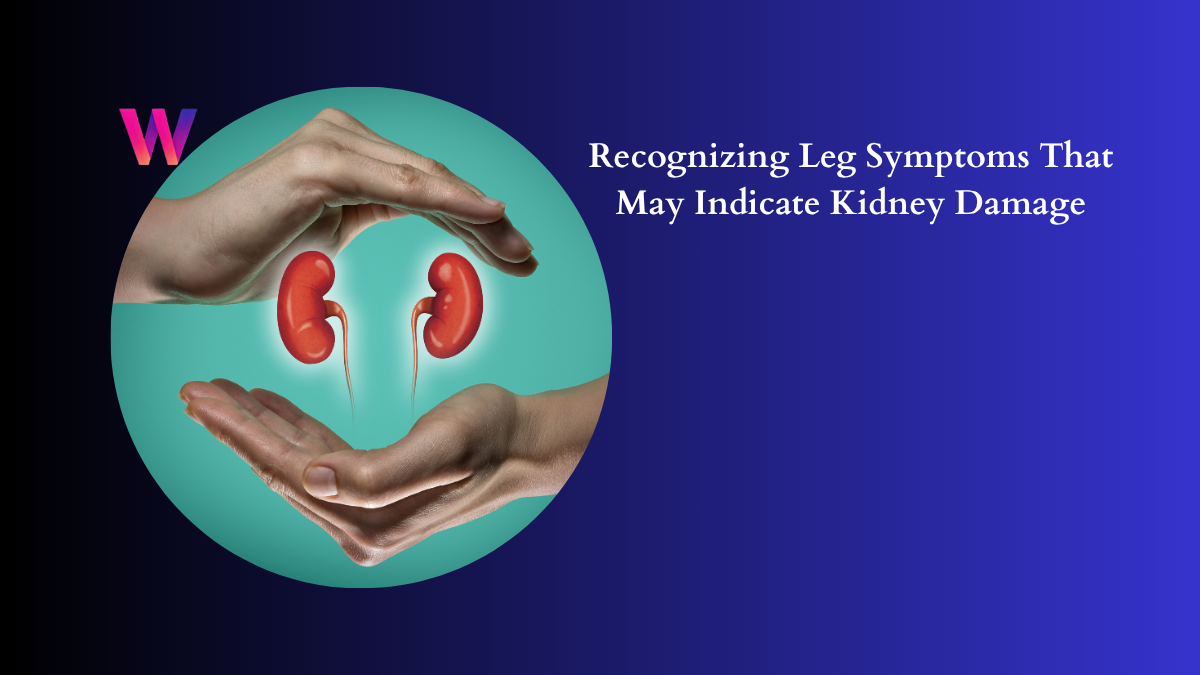The kidneys, two bean-shaped organs located on either side of the spine below the ribs, perform numerous critical functions essential for overall health. While often underappreciated until problems arise, their role extends far beyond simply producing urine. Understanding these functions is key to recognizing how their impairment can manifest throughout the body, including in the legs. This report delves into the various leg-related signs that can indicate underlying kidney damage, exploring their physiological basis, progression with chronic kidney disease (CKD), diagnostic approaches, and the importance of timely medical evaluation.
Table of Contents
Understanding Your Kidneys and the Silent Onset of Damage
A. The Vital Roles of Your Kidneys: More Than Just Filters
Healthy kidneys are powerhouses of regulation and filtration. Their primary functions include removing waste products and excess water from the blood, which are then excreted as urine. They play a crucial role in maintaining blood pressure, supporting bone health by balancing minerals like calcium and phosphorus, and aiding in the production of red blood cells. Furthermore, kidneys balance essential minerals and electrolytes in the body, such as sodium and potassium, which are vital for nerve and muscle function. When kidney function is compromised, these intricate processes are disrupted, leading to a cascade of health problems that can affect virtually every part of the body.
B. Chronic Kidney Disease (CKD): A Growing Concern, Often Unseen
Chronic Kidney Disease (CKD) is defined by the progressive and irreversible loss of kidney function over months or years. It represents a significant public health concern, with estimates suggesting that about 1 in 7 adults in the United States have CKD. Alarmingly, approximately 90% of adults with CKD are unaware they have the condition, primarily because early-stage kidney disease often presents with no noticeable symptoms. This silent nature means that kidney disease can advance undetected until it is quite advanced.
Several factors increase the risk of developing CKD. The most prominent are diabetes and high blood pressure (hypertension), which are responsible for about two-thirds of CKD cases. Other significant risk factors include heart disease or heart failure, a family history of CKD or kidney failure, obesity, being over the age of 60, a personal history of acute kidney injury (AKI), and smoking.
The kidneys possess a remarkable reserve capacity, meaning they can often compensate for a significant loss of function before overt systemic symptoms like severe fatigue or nausea become apparent. However, this “silent disease” paradox may be partially unraveled by paying closer attention to more localized signs. While systemic symptoms are often late indicators, certain manifestations in the legs, if correctly interpreted, could serve as earlier warnings for some individuals. For instance, disruptions in fluid balance leading to subtle swelling (edema) or the initial irritation of nerves due to accumulating metabolic wastes might cause leg discomfort even when overall kidney function is still in the mild to moderate stages of decline. An individual might notice new or worsening leg cramps or slight puffiness around the ankles before experiencing the more debilitating systemic effects of advanced kidney failure. Therefore, while not exclusively early signs, some leg symptoms can be among the first perceivable changes, offering a crucial window for earlier detection if their potential connection to kidney health is recognized.
Furthermore, the presence of major CKD risk factors, such as diabetes and hypertension, not only elevates the probability of kidney damage but can also independently cause or exacerbate leg symptoms. This creates a complex diagnostic picture and can potentially accelerate complications. Diabetes, a leading cause of CKD, is also a direct and common cause of peripheral neuropathy, which manifests with symptoms like numbness, tingling, and pain in the legs and feet. Similarly, hypertension, the second-leading cause of kidney failure, can contribute to fluid retention and edema. Consequently, if an individual with diabetes develops leg numbness, it could be due to diabetic neuropathy, uremic neuropathy stemming from CKD, or a combination of both, potentially leading to more severe symptoms. This interplay underscores the necessity for a thorough evaluation, including kidney function assessment, in individuals with these risk factors who present with leg symptoms, as these symptoms might be amplified or have dual causality.
Leg Swelling (Edema): A Common and Visible Red Flag
A. What is Kidney-Related Leg Swelling?
One of the most commonly reported and visually apparent signs associated with kidney dysfunction is edema, which refers to the accumulation of excess fluid within the body’s tissues. This fluid buildup often leads to noticeable puffiness or swelling, particularly in the lower extremities such as the ankles, feet, and legs. This type of swelling is often described as “peripheral edema.” A characteristic feature of this fluid retention is “pitting edema,” where pressing a finger firmly against the swollen area for a few seconds leaves a temporary indentation in the skin after the pressure is released. While leg swelling can occur for many reasons, its appearance, especially if new or worsening, warrants medical investigation for potential kidney involvement.
B. The Physiological Link: Why Damaged Kidneys Cause Fluid Retention
The development of edema in kidney disease is primarily linked to the kidneys’ diminished ability to perform their crucial roles in fluid and sodium balance. Healthy kidneys meticulously filter blood, removing excess sodium and water, which are then excreted in urine. When kidney function is impaired, this filtration process breaks down, leading to the retention of sodium and water in the body. This excess fluid then accumulates in the interstitial spaces of tissues, causing swelling.
Another significant factor contributing to edema in kidney disease is the loss of protein, particularly albumin, in the urine—a condition known as proteinuria or albuminuria. The tiny filtering units in the kidneys, called glomeruli, normally prevent large molecules like albumin from passing from the blood into the urine. However, when these filters are damaged, albumin can “leak” into the urine in significant amounts. Albumin in the blood plays a vital role in maintaining oncotic pressure, which helps to keep fluid within the blood vessels. When blood albumin levels drop due to urinary losses (hypoalbuminemia), this pressure decreases, allowing fluid to seep out of the capillaries and into the surrounding tissues, further contributing to edema. The presence of foamy urine is often an indicator of significant protein in the urine.
C. Edema Across CKD Stages: What to Expect
The presentation of edema can vary depending on the stage of chronic kidney disease. In the early stages of CKD (Stages 1 and 2), swelling may be subtle or entirely absent, as the kidneys may still be able to compensate adequately. However, as kidney function continues to decline into Stage 3 and beyond, edema often becomes more noticeable and persistent. Some sources suggest that swelling can be one of the common initial symptoms experienced by individuals once they reach Stage 3 CKD. The National Institute of Diabetes and Digestive and Kidney Diseases (NIDDK) notes that edema is more common when kidney disease is very advanced or when there is a substantial amount of protein leaking into the urine. The severity of swelling can range from mild puffiness, perhaps only noticeable at the end of the day or with tight-fitting shoes, to more significant and widespread edema affecting the entire lower legs.
Kidney-related edema is more than just a cosmetic concern or a simple issue of “water weight.” It is a visible manifestation of fluid overload that places considerable strain on the cardiovascular system. This direct link contributes significantly to the increased risk of heart disease and stroke observed in individuals with CKD. The sequence of events often begins with the kidneys’ failure to adequately excrete sodium and water, leading to an increase in overall blood volume. This expanded volume, in turn, elevates blood pressure. Chronic hypertension and persistent fluid overload directly stress the heart muscle, potentially leading to conditions such as heart failure. Heart failure itself can further exacerbate edema, creating a vicious cycle. Thus, leg swelling in the context of CKD is a critical external sign of internal processes that significantly elevate cardiovascular risk, which is a primary driver of morbidity and mortality in this patient population.
Furthermore, when edema is accompanied by foamy urine, it provides a strong diagnostic clue pointing towards damage to the glomeruli as a significant component of the kidney disease. This combination can have important prognostic implications. Healthy glomeruli act as sophisticated filters, preventing large proteins like albumin from escaping the bloodstream into the urine. The appearance of foamy urine is a well-recognized indicator of significant albuminuria. The substantial loss of albumin into the urine leads to reduced albumin levels in the blood (hypoalbuminemia). This decrease in plasma oncotic pressure allows fluid to shift from the blood vessels into the interstitial spaces, resulting in edema. Therefore, the concurrent presentation of leg swelling and foamy urine strongly suggests damage to the kidney’s primary filtration units. This pattern is often observed in conditions such as diabetic nephropathy (kidney disease due to diabetes) and various forms of glomerulonephritis (inflammation of the glomeruli), and the degree of albuminuria is a key marker of the severity of kidney damage.
Skin Deep: How Kidney Problems Manifest on Your Legs
Beyond swelling, kidney dysfunction can trigger a variety of noticeable changes in the skin of the legs and other parts of the body. These manifestations arise from the complex systemic disturbances caused by failing kidneys.
A. Persistent Itching (Uremic Pruritus): More Than Skin Deep
One of the most common and distressing symptoms experienced by individuals with kidney disease is persistent itching, medically termed uremic pruritus or CKD-associated pruritus (CKD-aP). This itching can be generalized, affecting large areas of the body, or localized to specific regions, including the legs. It is often described as severe, relentless, and particularly bothersome at night, frequently disrupting sleep and significantly impairing quality of life.
The exact physiological mechanisms underlying uremic pruritus are complex and not yet fully elucidated. However, research suggests a multifactorial interplay involving several factors. The buildup of uremic toxins in the blood, which healthy kidneys would normally filter out, is considered a primary contributor. Imbalances in minerals, such as elevated levels of phosphorus and calcium-phosphate products in the blood, are also implicated. Additionally, immune system dysregulation and a chronic inflammatory state, with increased levels of substances like histamine and cytokines, play a role. There is also evidence suggesting involvement of the nervous system, including an imbalance in opioid receptor activity (specifically, overstimulation of μ-opioid receptors and/or reduced activity of κ-opioid receptors) and potentially uremic neuropathy contributing to abnormal itch sensations.
Uremic pruritus can occur in earlier stages of CKD; one survey indicated that 58% of patients in Stage 2 CKD reported recurring itch, with this percentage rising slightly in Stages 3, 4, and 5. However, the severity of the itching tends to increase significantly in the later stages of kidney disease, particularly in patients with advanced CKD (Stage 4 and 5) and those undergoing dialysis.
B. Changes in Skin Color and Texture
Kidney disease can lead to several visible alterations in skin color and texture:
- Dry Skin (Xerosis): Extremely dry, tight, and sometimes cracked skin is a frequent complaint among individuals with CKD. This dryness is thought to result from changes in sweat gland function and oil production, as well as imbalances in minerals like phosphorus. Dry skin often coexists with and can exacerbate itching.
- Color Changes: The skin may take on an unhealthy pale tone, primarily due to anemia, which is a common complication of CKD resulting from reduced production of erythropoietin (a hormone that stimulates red blood cell production) by the damaged kidneys. A grayish or yellowish hue may also develop due to the accumulation of uremic pigments and toxins that are not effectively cleared by the failing kidneys. In some cases, areas of darkened skin (hyperpigmentation) may appear.
- Thickened, Leathery Skin and Other Lesions: Chronic, intense scratching due to pruritus can lead to secondary skin changes. The skin may become thickened and leathery (lichenification), and firm, itchy bumps (prurigo nodularis) or cysts can develop.
C. Rashes, Blisters, and Other Lesions
Beyond generalized dryness and color changes, more specific skin lesions can occur:
- Rashes: Some individuals with kidney disease, particularly in advanced stages, may develop rashes. These can manifest as small, dome-shaped, intensely itchy bumps, sometimes resembling prurigo nodularis, which can also coalesce to form rough, raised patches. These are often attributed to the accumulation of waste products that the kidneys are unable to eliminate.
- Blisters: The development of blisters on the skin, including on the hands, feet, and face, has been observed in some people with kidney disease, especially those with end-stage renal disease (ESRD). These blisters may open, dry, and crust over, potentially leaving scars.
- Calcium Deposits (Calcification): Due to the kidneys’ impaired ability to maintain mineral balance, some individuals may develop calcium deposits under the skin. These typically appear as hard, sometimes painless lumps, often located near joints. However, if they form in sensitive areas like fingertips, they can be painful.
D. Calciphylaxis: A Rare but Ominous Sign
Calciphylaxis is a rare but extremely serious and often life-threatening condition predominantly seen in patients with advanced kidney disease, particularly those on dialysis. It is characterized by the accumulation of calcium in the walls of small blood vessels in the skin and subcutaneous fat tissue. This process, known as vascular calcification, leads to blockage of these vessels, severely restricting blood flow and oxygen supply to the affected tissues.
The consequence is the development of intensely painful skin lesions that often begin as reddish or purplish, mottled areas or hardened plaques, which can then progress to non-healing ulcers and black, necrotic (dead) tissue. These lesions commonly occur on areas with more fatty tissue, such as the abdomen, thighs, and buttocks, but can also affect the legs and other parts of the body. Calciphylaxis carries a very high risk of severe infection, sepsis, and mortality. The appearance of such lesions on the legs is a critical warning sign requiring immediate and specialized medical attention, typically involving a multidisciplinary team.
The persistent and often severe itching associated with uremic pruritus frequently leads to an uncontrollable urge to scratch. This itch-scratch cycle can cause significant damage to the skin barrier, resulting in excoriations (scratch marks), lichenification (thickened, leathery skin), and the formation of prurigo nodularis (hard, intensely itchy bumps). These breaks in the skin create portals of entry for bacteria and other pathogens, substantially increasing the risk of secondary skin infections. This is particularly concerning because individuals with CKD often have a compromised immune system, making them more susceptible to infections and less capable of effectively fighting them off. Such infections can become serious, potentially leading to cellulitis or even systemic infections like sepsis, further adding to the burden of illness.
Furthermore, many of the skin changes observed in CKD, such as calcium deposits under the skin, and factors contributing to pruritus and dry skin, are often cutaneous manifestations of a broader systemic complication known as CKD-Mineral and Bone Disorder (CKD-MBD). This disorder involves complex dysregulation of phosphorus, calcium, parathyroid hormone (PTH), and vitamin D metabolism. Damaged kidneys struggle to excrete phosphorus, leading to hyperphosphatemia. They also fail to adequately activate vitamin D, which impairs calcium absorption from the gut and can lead to hypocalcemia. In response, the parathyroid glands increase PTH secretion (secondary hyperparathyroidism) to mobilize calcium from bones and increase phosphate excretion. The resulting high phosphorus levels, fluctuating calcium levels, and elevated PTH contribute to the deposition of calcium-phosphate products in soft tissues, including the skin (manifesting as calcium deposits) and blood vessels (a key factor in calciphylaxis). These mineral imbalances are also strongly implicated in the pathophysiology of uremic pruritus. Therefore, these skin signs serve as visible indicators of a complex systemic disorder that also adversely affects bone health and significantly increases cardiovascular risk.
Uncomfortable Sensations: Cramps and Restless Legs
Beyond visible skin changes and swelling, kidney damage can lead to distressing and uncomfortable sensations in the legs, primarily muscle cramps and Restless Leg Syndrome.
A. Muscle Cramps: The Unseen Imbalances
Muscle cramps, characterized by sudden, painful, and involuntary contractions of muscles, are a common complaint among individuals with kidney disease, particularly affecting the legs. These cramps can be debilitating, disrupt sleep, and significantly reduce quality of life.
The physiological basis for muscle cramps in CKD is thought to be multifactorial. Impaired kidney function leads to disturbances in fluid and electrolyte balance. Imbalances in key electrolytes such as calcium, magnesium, and potassium can interfere with normal muscle function and nerve signaling, predisposing to cramps. The accumulation of uremic toxins may also directly affect muscle and nerve excitability. Furthermore, nerve damage (uremic neuropathy) and problems with blood flow to the muscles can contribute to the development of cramps.
Muscle cramps can manifest at various stages of CKD. While some individuals may experience them in Stage 3, they tend to become more frequent or severe as kidney function declines further, particularly in advanced kidney disease (Stage 4 and 5). Dialysis treatments, especially hemodialysis, can sometimes trigger or worsen cramps due to the rapid shifts in fluid and electrolytes that occur during the procedure.
B. Restless Leg Syndrome (RLS): The Irresistible Urge to Move
Restless Leg Syndrome (RLS), also known as Willis-Ekbom disease, is a neurological sensory-motor disorder characterized by an overwhelming and often unpleasant urge to move the legs. This urge is typically accompanied by uncomfortable sensations described as creeping, crawling, pulling, throbbing, or tingling deep within the legs. A hallmark of RLS is that symptoms begin or worsen during periods of rest or inactivity, such as sitting or lying down, especially in the evening or at night. Movement, like walking or stretching, provides temporary relief.
RLS is significantly more prevalent in individuals with CKD compared to the general population, with some studies suggesting a prevalence that is two to six times higher, particularly among patients undergoing dialysis. The exact mechanisms linking RLS to CKD are not fully understood but are likely multifaceted. Several factors are thought to contribute, including iron deficiency and anemia (common in CKD), which can affect dopamine pathways in the brain involved in movement control. Dopamine dysregulation itself is a central theory in RLS pathogenesis. Other potential contributors in the CKD setting include the accumulation of uremic toxins, peripheral neuropathy, and electrolyte imbalances.
The impact of RLS on individuals with kidney disease can be profound. It frequently leads to difficulty initiating and maintaining sleep (insomnia), resulting in daytime fatigue, reduced concentration, and a significantly impaired quality of life. Given its prevalence and impact, RLS is an important but often underdiagnosed condition in the CKD population that warrants careful assessment and management.
Dialysis, while a life-sustaining treatment for end-stage renal disease, can present a paradox concerning muscle cramps and RLS. The rapid removal of fluid and solutes during hemodialysis can induce acute shifts in plasma osmolality and electrolyte concentrations, which are known triggers for muscle cramps. Similarly, while dialysis aims to clear uremic toxins, it may not effectively remove all substances implicated in RLS, or the intermittent nature of hemodialysis might lead to fluctuating toxin levels that provoke RLS symptoms. Indeed, RLS symptoms are often reported to occur or worsen during the inactivity of a hemodialysis session itself. This creates a clinical challenge where the treatment designed to alleviate uremic complications can inadvertently exacerbate these distressing leg symptoms, necessitating careful management of dialysis parameters, attention to fluid and electrolyte balance, and consideration of adjunctive therapies.
A crucial aspect of RLS in the context of CKD is its strong association with iron deficiency and anemia. CKD frequently leads to anemia due to reduced erythropoietin production by the failing kidneys and impaired iron metabolism or absorption. Iron is a vital cofactor in the synthesis of dopamine, a neurotransmitter whose dysfunction is central to many theories of RLS pathophysiology. Numerous studies have demonstrated a link between low iron stores (indicated by low serum ferritin or hemoglobin levels) and the presence or severity of RLS in CKD patients. This association is particularly important because it offers a potentially modifiable target for treatment. Correcting iron deficiency through appropriate supplementation (oral or intravenous) may alleviate RLS symptoms, thereby addressing a distressing neurological issue while also managing a common hematological complication of CKD. This highlights the importance of comprehensive anemia and iron status management in CKD patients, extending beyond simply stimulating red blood cell production.
Nerve Signals Disrupted: Peripheral Neuropathy in the Legs
Kidney disease can lead to significant nerve damage, a condition known as peripheral neuropathy, which frequently affects the legs and feet. This “uremic neuropathy” arises from the toxic environment created by failing kidneys.
A. Understanding Uremic Neuropathy
Peripheral neuropathy in the context of kidney disease refers to damage to the peripheral nerves—the nerves outside of the brain and spinal cord that transmit signals to and from the limbs and organs. Uremic neuropathy typically manifests as a distal, symmetric, sensorimotor polyneuropathy, meaning it usually affects both sides of the body equally, starts in the most distant parts of the nerves (feet and hands), and involves both sensory and motor nerve fibers.
Common symptoms experienced in the legs and feet include:
- Numbness or reduced sensation: Often described as feeling like wearing gloves or socks when one is not.
- Tingling or “pins and needles” sensations (paresthesia).
- Burning pain or sharp, jabbing pain.
- Muscle weakness: Difficulty lifting the foot or toes (foot drop), leading to an altered gait.
- Loss of reflexes.
- Impaired balance and coordination due to loss of position sense.
The physiological mechanisms leading to uremic neuropathy are complex and involve several factors related to kidney failure. The accumulation of uremic toxins, which are metabolic waste products that healthy kidneys normally excrete, is considered a primary cause of nerve damage. These toxins can directly harm nerve cells and their protective myelin sheaths, leading to axonal degradation and demyelination. Oxidative stress, an imbalance between free radicals and antioxidants, is also heightened in uremia and contributes to nerve injury. Electrolyte imbalances, particularly hyperkalemia (high potassium levels), can disrupt normal nerve impulse transmission. Chronic inflammation and potential deficiencies in certain nutrients may also play a role.
B. Progression and Impact of Neuropathy in CKD
Uremic neuropathy often develops insidiously and tends to worsen as kidney function declines. It becomes increasingly common and more severe in individuals with advanced CKD (Stage 4 and 5) and those with end-stage renal disease (ESRD) requiring dialysis. Studies suggest that a significant majority, potentially 60-90%, of dialysis patients experience some degree of peripheral neuropathy, and it is often associated with a glomerular filtration rate (GFR) falling below 12 mL/min. Some reports indicate that nerve problems, such as numbness in the fingers or toes, can become apparent in Stage 4 CKD.
The damage can affect different types of nerve fibers:
- Sensory nerves: Leading to pain, numbness, tingling, and altered temperature sensation, as well as impaired balance.
- Motor nerves: Resulting in muscle weakness, cramps, twitching, and eventually muscle atrophy (shrinking).
- Autonomic nerves: While less commonly highlighted for leg-specific symptoms, autonomic neuropathy is part of the broader uremic neuropathy spectrum and can affect functions like blood pressure regulation and sweating.
The impact of peripheral neuropathy on individuals with CKD is substantial. It can cause chronic pain, significantly impair mobility and daily functioning, and increase the risk of falls due to weakness and loss of balance. A particularly dangerous consequence is the loss of protective sensation in the feet, which can lead to unrecognized injuries, subsequent infections, and, in severe cases, the need for amputation, especially if diabetes is also present.
The sensory loss component of uremic neuropathy, especially in the feet, poses a silent but significant threat to limb integrity. When individuals lose the ability to feel pain, temperature, or pressure in their feet, they may not detect minor injuries such as cuts, blisters from ill-fitting shoes, burns from hot water, or pressure sores from prolonged immobility. These unnoticed injuries can easily worsen and become infected. This risk is compounded by the fact that CKD patients often have impaired wound healing capabilities and a compromised immune system, making it harder for their bodies to fight off infections. If coexisting conditions like diabetes (which itself causes neuropathy and impairs circulation) or peripheral artery disease (which reduces blood flow to the limbs) are present—and these are common comorbidities in the CKD population—the risk of severe, non-healing foot ulcers and subsequent amputation is dramatically increased. This underscores the critical importance of meticulous foot care and regular foot examinations for individuals with CKD and neuropathy.
Furthermore, in patients who develop kidney disease as a complication of diabetes (diabetic nephropathy, a leading cause of CKD), peripheral neuropathy is often the result of a “double hit.” They are susceptible to nerve damage from both the direct effects of long-standing diabetes (diabetic neuropathy) and the accumulation of uremic toxins due to failing kidney function (uremic neuropathy). Evidence suggests that diabetes and CKD may act as synergistic factors in the progression of peripheral neuropathy, meaning their combined effect is greater than the sum of their individual effects. This implies that neuropathy in patients with diabetic kidney disease may be more severe, progress more rapidly, and be more challenging to manage. Such individuals require diligent control of both their blood sugar levels and proactive management of their kidney disease to mitigate further nerve damage.
When Your Legs Send an SOS: Recognizing Signs and Seeking Help
The legs can provide crucial, albeit sometimes subtle, clues about the health of the kidneys. Recognizing these signals and understanding when to seek medical attention is paramount for early diagnosis and management of kidney disease.
A. The Importance of Vigilance: Don’t Dismiss Leg Symptoms
Many of the leg symptoms discussed—swelling, skin changes, cramps, restless sensations, numbness, or pain—can initially be mild or easily attributed to other, less serious causes, such as aging, minor injuries, or temporary discomforts. However, in the context of known risk factors for chronic kidney disease (such as diabetes, hypertension, heart disease, or a family history of kidney problems), these symptoms should not be dismissed and warrant careful attention.
Early detection of CKD is critical because interventions initiated in the earlier stages can significantly slow the progression of kidney damage, prevent or delay complications, and improve long-term outcomes. As one health organization advises, if an individual or a loved one experiences symptoms such as persistent swelling in the legs, it is crucial to schedule an appointment with a healthcare provider promptly, as early detection and intervention can markedly improve outcomes and prevent the progression of kidney disease.
B. When to Consult a Healthcare Professional
General guidance suggests consulting a healthcare professional if any of the discussed leg symptoms are persistent, worsen over time, or are of new onset, particularly if they are accompanied by other potential signs of kidney disease or if known CKD risk factors are present. Other potential CKD symptoms to be aware of include changes in urination (frequency, color, foamy appearance), unexplained fatigue, loss of appetite, or nausea.
Certain leg-related signs demand more urgent medical attention:
- Sudden and unexplained leg swelling.
- Leg swelling related to a physical injury.
- Swelling that occurs in only one leg, especially if accompanied by pain, coolness, or pale skin, as this could indicate a blood clot (deep vein thrombosis).
- Signs suggestive of calciphylaxis (extremely painful, purplish or black skin lesions).
- Rapidly worsening muscle weakness or inability to move parts of the leg.
If leg swelling is accompanied by symptoms like chest pain, difficulty breathing, shortness of breath (especially with activity or when lying flat), fainting, dizziness, or coughing up blood, immediate emergency medical assistance should be sought, as these could indicate a life-threatening condition such as a pulmonary embolism or a severe heart problem.
C. The Diagnostic Journey: What to Expect
When kidney disease is suspected based on leg symptoms or other indicators, a healthcare professional will typically begin with a thorough medical history, including family history of kidney disease, and a physical examination. The physical exam will include checking blood pressure, heart rate, and looking for signs like swelling in the legs and abdomen.
Several key diagnostic tests are then employed to assess kidney function and identify damage:
- Blood Tests:
- Estimated Glomerular Filtration Rate (eGFR): This is a primary test to evaluate kidney function. It is calculated from the level of creatinine (a waste product from muscle metabolism) in the blood, along with factors like age, sex, and sometimes race (though the use of race in eGFR calculation is becoming less common due to concerns about health disparities). A normal eGFR is generally 90 mL/min/1.73m² or higher. An eGFR below 60 mL/min/1.73m² for three months or more may indicate CKD.
- Blood Urea Nitrogen (BUN): This test measures the amount of urea nitrogen, another waste product from protein breakdown, in the blood. Elevated BUN levels can suggest impaired kidney function but can also be influenced by other factors like diet and hydration.
- Urine Tests:
- Urine Albumin-to-Creatinine Ratio (uACR): This test is crucial for detecting albumin (a type of protein) in the urine. Healthy kidneys prevent most albumin from passing into the urine. The presence of albumin (albuminuria or proteinuria) is a key marker of kidney damage, even if the eGFR is still in the normal range. A uACR value below 30 mg/g is considered normal; values above this suggest kidney damage.
- Urinalysis: A general analysis of the urine can detect blood, protein, white blood cells, and other abnormalities that might point to kidney problems or urinary tract infections.
- Imaging Tests:
- Ultrasound: Often the first imaging test used, ultrasound provides images of the kidneys’ size, structure, and can help identify obstructions (like kidney stones), cysts, or tumors. Small, scarred kidneys often suggest chronic disease.
- Computed Tomography (CT) Scan or Magnetic Resonance Imaging (MRI): These tests can provide more detailed images and may be used in specific situations to further evaluate kidney abnormalities or blood flow.
- Kidney Biopsy: In some cases, particularly when the cause of kidney disease is unclear or to assess the extent of damage, a kidney biopsy may be recommended. This procedure involves taking a small sample of kidney tissue, usually with a needle guided by ultrasound, for examination under a microscope.
It is critically important for individuals and healthcare providers to recognize the necessity of both an eGFR blood test and a uACR urine test for a comprehensive assessment of kidney health. Kidney damage, indicated by albuminuria (an elevated uACR), can be present even when the eGFR is still within the “normal” range. Relying solely on an eGFR measurement could therefore miss early stages of CKD where structural damage has begun but filtration capacity is not yet significantly reduced. If a patient presents with leg symptoms potentially related to kidney issues, and only an eGFR test is performed which happens to be normal, early kidney damage manifesting as albuminuria (which could be contributing to those leg symptoms through subtle mechanisms) might be overlooked. Advocating for this “two-test” approach is crucial when kidney disease is suspected.
Given that CKD symptoms can be non-specific or mild in the initial phases, and that healthcare providers might not always immediately connect common leg complaints to a potential kidney problem, individuals experiencing persistent leg symptoms, especially if they have risk factors for CKD, may need to take a proactive role in their diagnostic journey. Being informed about the potential link between their leg symptoms and kidney health empowers patients to engage in meaningful discussions with their doctors and specifically request comprehensive kidney function screening tests (both eGFR and uACR). This patient advocacy can be instrumental in facilitating earlier diagnosis and intervention.
Beyond the Kidneys: Acknowledging Other Causes of Leg Symptoms
While this report focuses on leg symptoms as potential indicators of kidney damage, it is essential to recognize that these symptoms are not exclusive to kidney disease. Many other medical conditions can cause similar manifestations in the legs. A thorough medical evaluation is crucial to differentiate kidney-related issues from other potential causes, ensuring an accurate diagnosis and appropriate treatment.
A. Differential Diagnosis: Why a Thorough Evaluation Matters
A differential diagnosis is the process of distinguishing a particular disease or condition from others that present with similar clinical features. For each category of leg symptom discussed, numerous alternative explanations exist:
- Edema (Leg Swelling): Besides kidney disease, leg swelling can be caused by heart failure (where the heart doesn’t pump blood effectively), liver disease (cirrhosis, which can alter fluid balance and protein production), chronic venous insufficiency (where veins in the legs have trouble returning blood to the heart), deep vein thrombosis (DVT, a blood clot in a leg vein), lymphedema (blockage in the lymphatic system), certain medications (e.g., calcium channel blockers, NSAIDs), pregnancy, and prolonged standing or sitting.
- Skin Issues (Itching, Rashes, Color Changes): Generalized itching (pruritus) can stem from primary skin conditions like eczema (dermatitis) or psoriasis, allergic reactions, insect bites, parasites (like scabies), liver disease (which can cause bile salt accumulation in the skin), thyroid disorders, certain cancers, iron deficiency anemia, or simply dry skin due to environmental factors or aging. Rashes on the legs can be due to contact dermatitis, fungal infections (like athlete’s foot), bacterial infections (cellulitis), psoriasis, eczema, vasculitis (inflammation of blood vessels), or insect bites.
- Muscle Cramps: Leg cramps can occur due to dehydration, electrolyte imbalances unrelated to kidney disease (e.g., from excessive sweating or certain medications like diuretics), muscle overuse or strain, inadequate blood flow to the muscles (peripheral artery disease), nerve compression in the spine, certain neurological conditions, thyroid disorders, or pregnancy.
- Restless Leg Syndrome (RLS): Common causes of RLS apart from kidney disease include iron deficiency (even without overt anemia), pregnancy, peripheral neuropathy from other causes (like diabetes), certain medications (e.g., some antidepressants, antihistamines), and neurological conditions like Parkinson’s disease. Genetic predisposition also plays a role.
- Peripheral Neuropathy: Diabetes is the most common cause of peripheral neuropathy overall. Other causes include alcohol use disorder, vitamin deficiencies (especially B vitamins like B12), infections (e.g., shingles, HIV, Lyme disease), autoimmune diseases (e.g., rheumatoid arthritis, lupus), exposure to toxins (heavy metals, industrial chemicals), certain medications (especially some chemotherapy drugs), inherited neuropathies, and traumatic nerve injury.
The presence of common leg symptoms can sometimes act as a “red herring,” drawing diagnostic attention towards a more immediately obvious or common cause, while a potential underlying kidney issue is overlooked. For example, if an individual presents with leg swelling and has known varicose veins, the swelling might be attributed solely to venous insufficiency. However, if that individual also has a significant risk factor for CKD, such as diabetes, the possibility that kidney disease is contributing to or is the primary cause of the edema could be missed if kidney function is not specifically evaluated. This highlights the critical need for a comprehensive assessment that includes kidney screening, especially in at-risk populations, even if an alternative explanation for the leg symptom seems apparent, to avoid diagnostic delays.
Furthermore, it is important to consider that kidney dysfunction can exacerbate symptoms of pre-existing leg conditions that are not primarily kidney-related. For instance, the fluid overload characteristic of CKD can worsen swelling that was initially due to chronic venous insufficiency. Similarly, the accumulation of uremic toxins in CKD can aggravate nerve damage in someone who already has peripheral neuropathy from long-standing diabetes. This “compounding effect” means that a sudden or significant worsening of a chronic leg symptom, even if the initial symptom had a different origin, could signal the new onset or progression of kidney disease and should prompt a re-evaluation that includes kidney function tests.
Protecting Your Kidneys, Protecting Your Legs: A Proactive Approach
Recognizing leg symptoms as potential indicators of kidney damage is the first step. The next involves proactive measures to protect kidney health, manage existing conditions, and work collaboratively with healthcare providers.
A. General Kidney Health Strategies
Adopting a healthy lifestyle can play a significant role in preserving kidney function and overall health. Key strategies include:
- Following a Kidney-Friendly Eating Plan: This often involves a diet low in sodium (salt), processed foods, and unhealthy fats. For individuals with established kidney disease, dietary modifications may also include controlled intake of protein, phosphorus, and potassium, as advised by a healthcare professional or renal dietitian. Emphasizing fruits, vegetables, and whole grains is generally beneficial.
- Regular Physical Activity: Aiming for at least 30 minutes of moderate-intensity exercise on most days of the week can help manage weight, blood pressure, and blood sugar levels.
- Maintaining a Healthy Weight: Obesity is a risk factor for CKD and its progression.
- Quitting Smoking and Tobacco Use: Smoking damages blood vessels and can worsen kidney disease and increase cardiovascular risk.
- Limiting Alcohol Consumption: Excessive alcohol intake can raise blood pressure and contribute to kidney damage.
- Staying Hydrated: Adequate fluid intake is generally important for kidney health, helping them flush out waste products. However, individuals with advanced kidney disease may need to restrict fluid intake, so personalized advice from a doctor is crucial.
B. Managing Underlying Conditions: A Key to Kidney Preservation
Since diabetes and high blood pressure are the leading causes of CKD, their meticulous management is paramount for kidney protection. This involves:
- Strict Blood Sugar Control: For individuals with diabetes, maintaining blood glucose levels within the target range recommended by their healthcare provider is essential to prevent or slow the progression of diabetic nephropathy.
- Effective Blood Pressure Management: Keeping blood pressure below target levels (often below 130/80 mmHg for people with CKD, though individual goals may vary) through lifestyle changes and, if necessary, medication, is crucial to reduce strain on the kidneys.
- Avoiding Overuse of NSAIDs: Nonsteroidal anti-inflammatory drugs (NSAIDs) such as ibuprofen and naproxen, especially when used frequently or in high doses, can harm the kidneys, particularly in individuals who are already at risk or have existing kidney disease. Safer pain relief alternatives should be discussed with a doctor.
C. Working with Your Healthcare Team
A collaborative relationship with healthcare providers is fundamental to managing kidney health and addressing any leg symptoms that may arise:
- Regular Check-ups: Attending regular medical appointments is important, especially for individuals with risk factors for CKD. These visits allow for routine monitoring of kidney function (e.g., eGFR and uACR tests), blood pressure, and blood sugar.
- Adherence to Treatment: Following prescribed treatment plans, including medications for blood pressure, diabetes, or specific kidney complications, is vital.
- Open Communication: Individuals should feel empowered to discuss any new, worsening, or concerning symptoms with their healthcare team, including those affecting their legs. No symptom should be considered too trivial if it is causing concern.
The management of leg symptoms such as pain from neuropathy, severe itching, or debilitating edema is not merely about providing comfort; it is an integral component of holistic CKD care. These symptoms can significantly impact a patient’s ability to adhere to life-saving treatments, such as dialysis, and can interfere with the effective management of comorbidities, like diabetic foot care. For example, severe leg pain or unbearable itching can make it extremely difficult for patients to remain still during dialysis sessions or to engage in necessary physical activity. Poorly managed edema can lead to skin breakdown, increasing the risk of infections in already vulnerable individuals. Failure to adequately address these distressing leg symptoms can lead to a decline in overall well-being, potentially affecting nutritional status, mental health, and the capacity to manage other complex aspects of their CKD care. Therefore, proactive and effective management of leg symptoms is not just palliative but a crucial element of comprehensive care that can improve treatment adherence, reduce complications, and enhance quality of life.
Furthermore, changes observed in certain leg symptoms can sometimes serve as an informal, patient-centered barometer for the effectiveness of CKD management strategies. For instance, a noticeable reduction in leg swelling following the initiation of diuretics or improved adherence to fluid and sodium restrictions can be a tangible and encouraging sign that treatment is working. Similarly, if an individual with RLS and documented iron deficiency receives appropriate iron therapy, an improvement in their RLS symptoms can indicate successful iron repletion and a positive therapeutic response. Conversely, the worsening of leg symptoms despite ongoing treatment might signal disease progression or the need to re-evaluate and adjust the current management plan. While these subjective changes do not replace objective measures of kidney function like eGFR and uACR, patient-reported improvements or deteriorations in leg symptoms can provide valuable real-time feedback to both the individual and their clinician regarding treatment efficacy and the overall trajectory of their condition.
Conclusion: Listening to Your Legs, Protecting Your Kidneys
The legs can indeed offer silent signals that point towards underlying kidney damage. Symptoms such as persistent swelling (edema), various skin changes including chronic itching (uremic pruritus), alterations in skin color and texture, rashes, and the rare but severe condition of calciphylaxis, as well as uncomfortable sensations like muscle cramps, Restless Leg Syndrome, and the numbness, tingling, or pain of peripheral neuropathy, can all be manifestations of impaired kidney function.
Chronic kidney disease often progresses silently in its early stages, making the recognition of these, sometimes subtle, leg-related signs particularly important, especially for individuals with known risk factors like diabetes, hypertension, or a family history of kidney disease. While many of these leg symptoms can also be caused by other medical conditions, their new onset, persistence, or worsening warrants prompt medical evaluation to rule out or confirm kidney involvement.
The diagnostic process typically involves a combination of blood tests (such as eGFR and BUN) and urine tests (particularly uACR) to assess kidney function and detect damage, often supplemented by imaging studies or, in specific cases, a kidney biopsy. Early detection through these tests, potentially prompted by concerning leg symptoms, allows for timely interventions that can slow the progression of CKD, manage complications, and preserve quality of life.
Ultimately, a proactive approach to health, including managing underlying conditions like diabetes and hypertension, adopting a kidney-friendly lifestyle, and maintaining open communication with healthcare providers, is crucial. Paying attention to what your legs might be telling you and seeking medical advice when concerns arise are vital steps in safeguarding kidney health and overall well-being.











